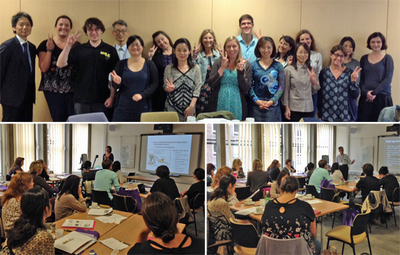15/09/2015
 |
On the 8th of September, approximately 17 teachers came to the Institute of Education to share ideas about teaching Japanese in their primary schools and then hear about the new Japan Foundation Japanese Scheme of Work for Primary Schools. The event started with presentations from primary school teachers to share how they have used the scheme of work along with showing useful resources that they have tried in their classes. First Catherine Duke, from Holbrook Primary School, in Trowbridge, introduced how to make animations with the children while they learn Japanese. She showed how her class had used an ipad and their own drawings to create an animation for “We’re Going on a Bear Hunt” which the children had narrated in Japanese. Catherine also showed lots of other ways this could be adapted to use kamishibai or other stories in Japanese. Then, Helen Morris, from Madley Primary School in Herefordshire, showed how she used and adapted the Japan Foundation’s scheme of work for her classes. Her lesson plans extended the scheme of work to include shopping dialogues. Her pupils acted out shopping for cute erasers using animal vocabulary, colours and prices and then researched about Japanese erasers online. It was great to see how her classes loved learning and performing dialogues, especially when they could vary the vocabulary themselves. Next , Yoko Leedham shared her lesson plans and ideas for her Japanese Enrichment classes at St Osmund's school in Dorchester. Yoko teaches a set of 7 weeks of Japanese classes including activities ranging from teaching basic greetings to making hanko stamps, and writing their names using Japanese calligraphy. This was followed by a talk by Dr Marina Sereda-Linley who spoke about differentiation in Primary Japanese Lessons, giving several examples of how it is possible to give slightly different activities to children within the same class, depending on their competencies. Dr Sereda-Linley gave lots of concrete examples of using materials with different levels of support and different levels of challenge. She showed how it is possible to present ideas through auditory, visual and kinesthetic means, to help children’s varied learning styles. Lastly the Japan Foundation’s Chief Language Advisor, Makoto Netsu, introduced the new resources for the Japan Foundation Japanese Scheme of Work for Primary Schools. These teaching materials have been tested with two classes of Year 4 pupils at Southfield Primary School so Mr Netsu gave explanations about how he has used them, and how they might be adapted for other primary Japanese classes. The resources themselves include worksheets, plans, activities, games etc. One participant, Emily Mellor, commented “I feel very inspired to get started in school and have loads of ideas." Another mentioned that “It was very interesting to see what other teachers are doing in their classes." The Japan Foundation would like to thank all the fantastic teachers that were willing to share their ideas. If you are interested in the ideas and resources shared during this event, some of them are available to download below. |
| |



 Japanese Language Navigation
Japanese Language Navigation
